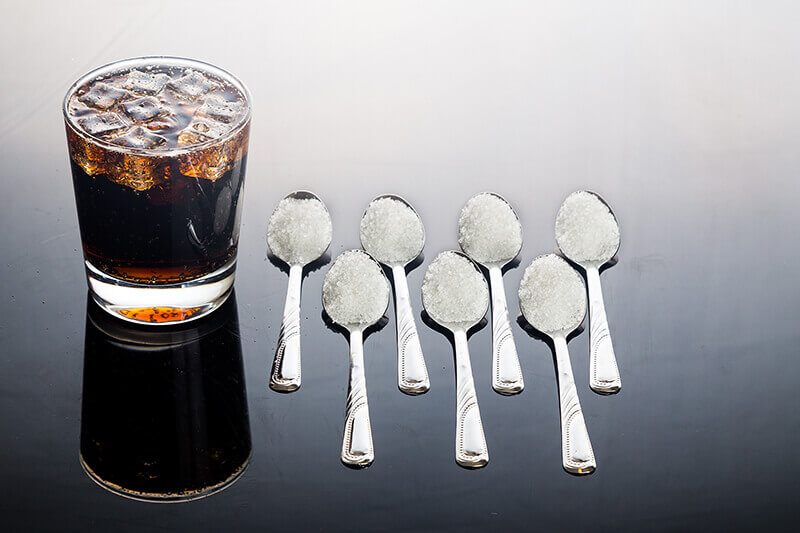May 2, 2019
Bittersweet finding: Soft drinks, including diet sodas, contribute to increased sugar intake and total calorie consumption in children

A new study reports that children ages 2-17 who drink sweetened beverages, including diet and regular sodas, have higher sugar and calorie intake than children who consume unsweetened alternatives, like water. (File photo).
WEST LAFAYETTE, Ind. – Children who enjoy sweetened soft drinks consume more total calories and sugar compared with their water- and milk-drinking peers, according to a new study, “Consumption of Low-calorie Sweetened Beverages is Associated with Higher Total Energy and Sugar Intake Among Children, NHANES 2011-2016,” published Thursday (May 2) in the journal Pediatric Obesity.
Susan E. Swithers, a professor in Purdue University’s Department of Psychological Sciences, is a co-author of the study, which sought to understand the effects of consuming beverages that contain artificial sweeteners on children’s eating and drinking patterns.
“We don’t usually think about it this way, but drinking a soda is not so different from eating a candy bar,” Swithers said. “As adults wouldn’t eat a full-size candy bar with all of our meals, even if it was sugar-free. We also wouldn’t think that giving a kid a candy bar every day was a particularly healthy choice, even if that candy bar was sugar-free. Somehow having a soda seems different to us, but they really are just candy in a can. We shouldn’t really be surprised that drinking soda, even diet soda, doesn’t produce benefits compared to drinking water or other unsweetened drinks.”
In this study, the researchers compared children ages 2-17 who drank unsweetened beverages (milk and water) with those who drank only sugary drinks (sodas and 100 percent juices), those who drank beverages that contained low calorie sweeteners (diet soda), and to those who drank both sugary and artificially-sweetened drinks.
 A new study reports that children who enjoy sweetened soft drinks consume more total calories and sugar compared with their water- and milk-drinking peers.
Download image
A new study reports that children who enjoy sweetened soft drinks consume more total calories and sugar compared with their water- and milk-drinking peers.
Download image
The participants who consumed unsweetened beverages reported the lowest overall total calorie intake at about 1,560 calories per day. Drinkers of either sugary or artificially-sweetened beverages consumed similar amounts of energy daily, but both were higher than those in the unsweetened group. The largest intakes of energy, however, were seen in children who drank both types of sweetened beverages at around 2,010 calories daily, an increase of almost 30%. Total sugar intake and added sugar intake were also greatest in children consuming both sugary and artificially-sweetened beverages.
“These data suggest that instead of using diet soft drinks as substitutes for sugary beverages, children may actually be adding them to their normal sugar intake,” Swithers said. “Such high intakes of sugar and sugar substitutes are problematic, because they have been hypothesized to groom children’s’ palates to expect that foods are supposed to taste incredibly sweet. They may not want an apple anymore when they’re used to hypersweet foods and beverages.”
Swithers said one theory in psychology called classical conditioning might explain how sugar substitutes could promote greater consumption of sugar. Classical conditioning is a type of learning in which the body pairs sensory input, such as taste, with a corresponding biological response.
With sugar, the sweet taste activates the body’s metabolic functions so that it can more efficiently process the incoming energy. With artificial sweeteners, the sweet taste occurs but the energy doesn’t arrive. This may lead the body to stop responding to the sweet taste stimulus even when real sugar arrives, as has been shown in rodent studies. In those studies, when sugar actually reappeared after artificial sweeteners, the animal was not prepared to absorb the energy and reacted more slowly. This is one way artificial sweeteners may cause a slower metabolism, which could lead to weight gain or health complications, like Type 2 diabetes.
“Our brain could be making our responses become slower and smaller,” Swithers said. “The work in my lab is designed to understand whether or not this process of classical conditioning is actually happening and what long-term consequences or metabolic mechanisms could be underlying it, using carefully controlled pre-clinical models. Studies like this current one in children provide evidence for the fact that consuming artificial sweeteners doesn’t always produce the decreases in energy intake you would predict, and the laboratory studies in rodents provide a possible explanation for why that happens.”
The food and beverage industry has funded some studies reporting the opposite: Artificially sweetened beverages are related to reduced sugar consumption and, therefore, weight.
“By focusing on artificial sweeteners’ effect on weight, the industry pushes this public health crisis onto individuals’ food choices without recognizing it’s already difficult, expensive and time-consuming for consumers to get access to healthy food,” Swithers said. “For example, industry-funded studies which purport to compare diet soda drinkers to water consumers actually included people who drink regular sodas in the “water” group. This misleads consumers into thinking that diet sodas are better choice than water. The data just don’t support that kind of conclusion.”
Swithers said this distortion could confuse consumers about their healthiest food options. The influence could become limiting for consumers further constrained by economic boundaries.
“We consume way too much sweetener whether actual sugar or a substitute. It’s not a healthy pattern to drink a sweetened beverage every day,” Swithers said. “No evidence supports that health risks like diabetes or high blood pressure are lessened by artificial sugars. It is definitely possible for a regular or diet soda to be a part of a healthy diet, but as an occasional indulgence not as a regular, daily choice.”
Allison C. Sylvetsky, an assistant professor of exercise and nutrition sciences at the George Washington University’s Milken Institute School of Public Health is the lead author of the study. Other co-authors include Jean Welsh and Janet Figueroa at Emory University. Talia Zimmerman, a research assistant at the George Washington University and undergraduate student at Georgetown University, also contributed to the study.
The Sumner M. Redstone Global Center for Prevention and Wellness at the Milken Institute SPH funded the research.
Swithers’ research aligns with Purdue's Giant Leaps celebration of the university’s global advancements made in health, space, artificial intelligence and sustainability as part of Purdue’s 150th anniversary. Those are the four themes of the yearlong celebration’s Ideas Festival, designed to showcase Purdue as an intellectual center solving real-world issues.
Swithers plans to continue her research into sweetener consumption and classical conditioning, and funding from health organizations could help her reach her next steps.
Purdue Research Foundation Contact: Cynthia Sequin, 765-558-3340, casequin@prf.org
Source: Susan Swithers, swithers@purdue.edu
ABSTRACT
Consumption of low-calorie sweetened beverages is associated with higher total energy and sugar intake among children, NHANES 2011-2016
Allison C. Sylvetsky, Janet Figueroa, Talia Zimmerman, Susan E. Swithers
Objective: To examine associations between consumption of low‐calorie sweetened beverages (LCSBs), sugar, and total energy intake in children in the United States.
Methods: We used 24‐hour dietary recalls from 7026 children enrolled in the National Health and Nutrition Examination Survey (NHANES) 2011 to 2016 to assess energy and macronutrient intake among LCSB (≥4 oz LCSB, <4 oz SB), SB (≥4 oz SB, <4 oz LCSB), and LCSB + SB consumers (≥4 oz each) compared with water consumers (≥4 oz water, <4 oz LCSB and SBs). Sample weights and complex survey procedures were used for all analyses.
Results: Adjusting for body mass index (BMI) percentile, LCSB, SB, and LCSB + SB consumption was associated with 196, 312, and 450 more total calories and 15, 39, and 46 more calories from added sugar, respectively, compared with water consumers (P < .05 for all pairwise comparisons). No differences in energy intake were observed between LCSB and SB consumers.
Conclusions: These findings challenge the utility of LCSB for weight management in children and adolescents.

